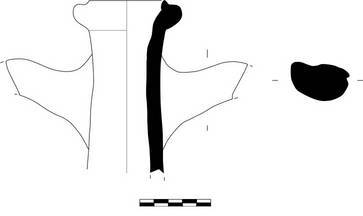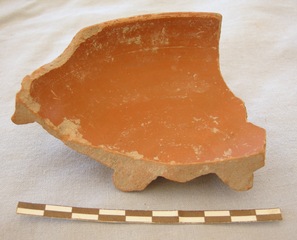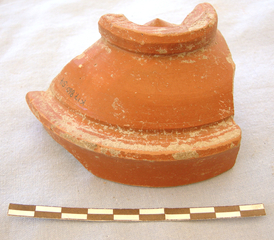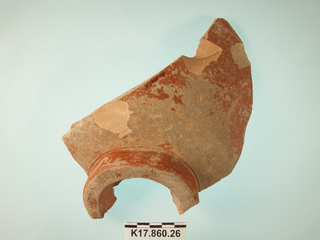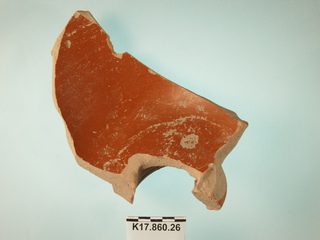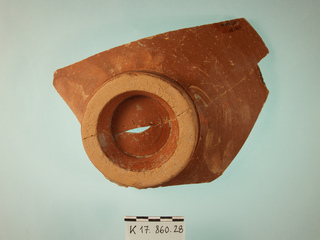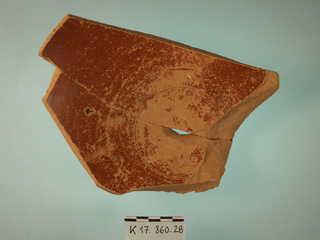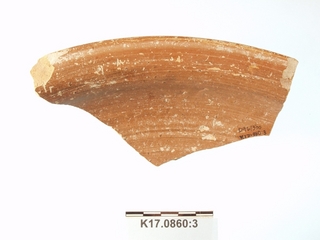Greek, Roman and Byzantine Pottery at Ilion (Troia):
Sebastian Heath and Billur Tekkök, Editors
Late Severan Dumping
Please note that this is a public draft of work in progress
1. Eastern Sigillata A Hayes Form 4 Profile (Late 2nd Century BC to Augustan)
P. H. .041. Est. diam. rim .24 (1/3 preserved).
K17.0937:26. Very fine fabric is somewhat pink for ware (7.5YR 8/4).Slip is dark red (10R 4/6).
p. 16, pl 1.
K17.0937-26.jpg
2. Eastern Sigillata A Hayes Form 29 Rim (Augustan and later)
P. H. .019. Est. diam. rim .18 (1/20 preserved). Th. .0054.
K17.0860:24. Single sherd. Pale fabric (7.5 8/4) and deep-red slip (10R 4/6).
K17.0860-24.jpg
3. Eastern Sigillata A Hayes Form 45 Profile (early to mid-1st century AD)
P. H. .035. Est. diam. rim .08 (1/3 preserved). Th. .0054.
K17.0860:50. Single sherd, profile. Fine pale (near 7.5YR 8/3) fabric with no visible inclusions. Deep red slip (10R 4/6 where thickest). Pronounced scratches and voids on surface. Double dipping streak.
p. 34, pl. 6.
K17.0860-50.jpg
4. Italian Sigillata Conspectus Form 23.2 Conical Cup (50-100)
P. H. .033. Est. diam. rim .07 (1/4 preserved). Th. .02.
K/L16/17.0100:6. Single rim sherd. Fine pale red (2.5YR 6/6) fabric with very rare tiny light inclusions. Slip is dark red (nearest 2.5YR 4/8). Molded double scroll on outer face of rim.
Cf. form 23.
svg/K-L16-17.0100-6.jpg
5. Eastern Sigillata Bi Ring Foot (late 1st Century BC - early 1st Century AD)
P. H. .0162. Est. diam. base .041 (5/6 preserved). Th. .0031.
K17.0860.103. P0517. Nearly complete base. Fine orange brown (2.5YR 6/8) fabric with tiny golden mica. Interior is covered with thick and very smooth orange (2.5YR 4/8) slip, duller on underside. Groove on resting surface of foot. 'ΔΩ/ΡΟΝ' stamp.
6. Eastern Sigillata Bii Hayes Form 58 (AD 50-125)
H. .025. Est. diam. rim .14 (1/10 preserved). Th. .0043.
K17.0860:59. Single rim sherd. Soft, brown (5YR 6/6) fabric with frequent tiny mica. Flaking, red slip (near 10R 4/8) . Single incised line under rim.
, p. 63, tavola 14.3.
K17.0860-59.jpg
7. Eastern Sigillata Bii Hayes Form 58 (AD 50-125)
H. .026. Est. diam. rim .145 (1/8 preserved). Th. .0068.
K17.0860:60. Single rim sherd. Soft, reddish brown (2.5YR 6/8) fabric with frequent tiny mica. The thick darker slip (2.5YR 6/8) is flaking off.
, p. 63, tavola 14.3.
K17.0860-60.jpg
8. Eastern Sigillata Bii Type 58 Base, fired black (AD 50 to 125)
P. H. .011. Est. diam. base .11 (1/5 preserved). Th. .0038.
K/L16/17.0100:26. Greenish gray (10YR 6/3) fabric with frequent mica. Thick polished black slip on all extant surfaces. Light groove outside of base on exterior.
svg/K-L16-17.0100-26.jpg
9. Eastern Sigillata Bii Hayes Form 60b (100-150)
H. .042. Est. diam. rim .20 (1/10 preserved). Th. .0055.
K17.0860:49. Single rim sherd. Soft, reddish brown (2.5YR 5/6) fabric with frequent tiny mica. Lighter (2.5YR 5/8) slip on all preserved surfaces.
, p. 63, tavola 14.7. Cf. , no. 89a for date.
K17.0860-49.jpg
10. Çandarli Loeschke Form 15 Rim (AD 50 to 100)
H. .0356. Est. diam. rim .08 (<1/20 preserved). Th. .0051.
K17.0860:36. Single rim sherd. Somewhat brown (nearest 5YR 6/6) fabric, small golden mica. No other inclusions visible except under 10x when a few tiny lighter bits appear. Slip is red (near 2.5YR 4/8), thick and smooth on all surfaces. Brush marks are very clear on interior of rim. Tooled smoothing bands on wall. Exterior is relatively smooth, no scratches on wall.
K17.0860-36.jpg
11. Çandarli Loeschke Form 19 Flanged Bowl Rim (75 to 150)
H. .051. Est. diam. rim .11 (1/3 preserved). Th. .0046.
K17.0860:33. Two joining sherds, profile. Light red (10R 6/8) fabric with mostly frequent lime but also darker bits and frequent very small voids. Mica on surface. Slip is red (10R 5/8), slightly smoother and thicker on interior.
K17.0860-33.jpg
12. Çandarli Hayes Form 3 Flanged Bowl Rim (Third Century AD)
H. .052. Est. diam. rim .12 (1/5 preserved). Th. .0039.
K17.0860:54. Single sherd, profile. Light red (2.5YR 6/6) fabric with tiny lime and other varied tiny inclusions. Occasional very small voids. Occasional gold mica. Dark red (10 4/6 where thickest) red slip, which is smooth and slightly glossy on interior. The exterior slip is mostly thinner but there is a patch where it is very thick and dark, particularly under the flange. There is a very fine line incised on the interior.
K17.0860-54.jpg
13. Candarli Loeschke Form 26a Bowl (50-100)
H. .05. Est. diam. rim .23 (1/4 preserved). Est. diam. base .10 (1/2 preserved). Th. .0049.
K17.0937:1. SC11-2ee. Two joining sherds, complete profile. Light red (2.5YR 6/8) fabric with rare tiny white inclusions, frequent mica. Large lime chunks, .002 in diameter, are visible in breaks and on surface (perhaps from post-depositional spalling?). Elongated voids, particularly near foot. Thick red (10R 5/8) slip on interior is smoothed, exterior matte and thinner. Conserved. Lightly incised groove around center of floor, very light groove on lowest wall.
K17.0937-1.jpg
14. Çandarli Hayes Form 1 Base (2nd - 3rd Century)
P. H. .128. Est. diam. base .0958 (1/2 preserved).
K17.0860:26. Single base sherd. Pale pink (near 5YR 7/4) fabric with tiny varied, mostly light bits and occasional small reddish inclusions. Small voids, some elongated and up to .004 in length. Red (10R 4/8) slip is smoothed on interior with bands visible; thinner, matte on exterior with a few, short patches almost plain. Distinct groove between heavy foot and wall. Two spacer impressions on interior floor, both .0142 in diameter.
K17.0860-26.jpg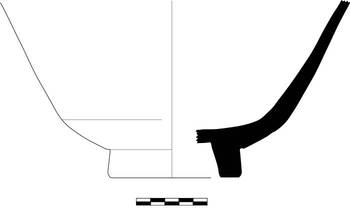
15. Çandarli Hayes Form 1 (Cf. Knossos 6) Base (2nd - 3rd Century)
P. H. .078. Est. diam. base .0966 (completely preserved). Th. .0059.
K17.0860:28. Two joining base sherds. Pale red (5YR 7/4) fabric with elongated and sub-rounded light, mostly calcareous, inclusions. Frequent very small irregular and elongated voids. Chip taken near base. Surface is darker red (10R 4/6). Thick and smoothed on interior. Exterior is thinner and is well smoothed only in wide bands. There is a floral stamp at the center of the floor but the design is not restorable. There is a single concentric circle around this central stamp. Two closely spaced incised lines on exterior. Two impressions of circular spacers are extant. One is .0125 in diameter, the other is .0142. The smaller has two chunks of the spacer adhering in the impression. The fabric of the spacer fragment is basically normal Candarli red (near 2.5YR 5/6, but small and hard to read). [N.B. the spacer may well have been fired many times so its is not necessarily indicative of much.] The slip and interior incised concentric groove go under the larger space remnant. This suggests that the bowl was brought to a “leather hard” stage when groove was “cut” and slip was applied. Then the piece was stacked in a kiln with spacers between the pieces. There is also a single spacer outline on the bottom of the ring foot. The diameter of this is not recoverable but may be near .0125. All the slip has worn off the bottom of the ring foot.
K17.0860-28.jpg
16. Çandarli Hayes Form 4 Rim (200-300)
H. .034. Est. diam. rim .20 (1/12 preserved). Th. .005.
K/L16/17.0100:18. Single rim sherd. Compact red (2.5YR 5/6) fabric, no inclusions, occasional elongated voids; darker (10R 5/6) red slip on all surfaces.
p. 78, pl. XVIII.4.
svg/K-L16-17.0100-18.jpg
17. Pontic Sigillata Cup with Garland Decoration
Th. .0037.
K17.0937:49. Two joining body sherds. Stance uncertain. Compact fabric with feint reddish (2.5YR 6/8) core turning slightly more brown towards surfaces. Occasional small voids, essentially no other visible inclusions. Thin matte darker orange (around 2.5YR 5/8) slip on preserved surfaces, even darker in thicker patches. Decorated with garland appliqué.
Cf. , nos. 1474-1477; p. 143 and fig. 4.5e.
K17.0937-49.jpg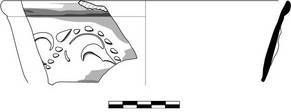
18. “Brown Slip” Sigillata Bowl (Early Roman)
P. H. .087. Est. diam. rim .41 (1/10 preserved). Th. .0084.
K17.0860:3. Single large rim sherd. Light brown fabric (5YR 6/6) is compact with occasional rounded white inclusions (.004 in size) and other angular bits of similar size; there are also tiny bits visible at 10x. Thick brown slip (just lighter than 5YR 4/6) on all surfaces. Surfaces are brushed and darker where slip is thickest. As usual for the ware, there are “flattened bumps” under the interior slip, which is darkest over bumps. Two grooves on exterior wall.
19. “Brown Slip” Sigillata Bowl, Recurved Handle
P. H. .051. Est. diam. rim .285 (1/20 preserved). Th. .0065.
K17.0860:42. Single rim sherd with handle. Light red (2.5YR 7/8) “regional type” fine fabric. Interior slip is unsmoothed so slightly ‘bumpy’. It is dark red-brown (5YR 3/3). The exterior is encrusted but possible a little lighter. There are ridges below the handle and the slip is distinctly thinner at the top of these.
K17.0860-42.jpg
20. Roman Period Lead Glazed Skyphos (BC 50 - 10 AD)
P. H. .038. Est. diam. rim .085. Th. .0034.
K17.0860:2. Single rim sherd with beginning of horizontal handle at rim. Brownish green glaze (nearest 2.5Y 5/6). Light reddish brown (5YR 5/4) fabric. Angular lime inclusions, one as large as .004, otherwise small to tiny.
Cf. form 1.
K17.0860-2.jpg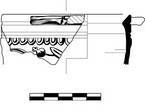
21. African Red-Slip Hayes 50a Rim (AD 230-320)
Th. .004.
K/L16/17.0100:17. Single rim sherd. Red (10R 5/8) fabric with no visible inclusions. Slip slightly redder than fabric. This sherd was recovered in third century pits and represents the first phase of ARS imports at Ilion.
For form see p. 69.
svg/K-L16-17.0100-17.jpg
22. Cooking Pan (Early Roman)
P. H. .053. Est. diam. rim .28 (1/10 preserved).
K/L16/17.0100:32. Single sherd, rim to just below carination/floor. Granular reddish-brown (2.5YR 5/4) fabric with frequent small light inclusions. Surface gray. The vessel is not flat below the carination so no part of the floor is extant.
Cf. P29, but with no groove on rim.
svg/K-L16-17.0100-32.jpg
23. Gritty Gray Cookingware Flanged Casserole
P. H. .049. Est. diam. rim .30 (1/12 preserved). Th. .0084.
K/L16/17.0100:34. Single rim sherd. Coarse brown (2.5YR 4/4) fabric with frequent, mostly light sand angular inclusions. Surface near black. Light exterior ridging.
svg/K-L16-17.0100-34.jpg
24. Gritty Gray Cookingware Flanged Casserole
P. H. .045. Est. diam. rim .24 (<1/10 preserved). Th. .0073.
K/L16/17.0100:33. Single rim sherd. Coarse brown (2.5YR 4/4) fabric with very frequent, mostly light and reddish sand angular inclusions. Surface near black. Very light exterior ridging.
svg/K-L16-17.0100-33.jpg
25. Unclassified Cookpot, perhaps imitating Phocaean form
K/L16/17.0100:11. Single sherd. P.H. .092, est. D. rim .315 (1/6 preserved), min. th. wall .0073. Light reddish-brown (5YR 6/3) fabric with abundant tiny “mottled lime” inclusions. Surface is generally pale red (10R 6/3) in lower preserved parts but becomes gray near and over rim. A short span (.045) of the outer edge of the rim has a vitrified surface. Wide ridges on exterior.
svg/K-L16-17.0100-11.jpg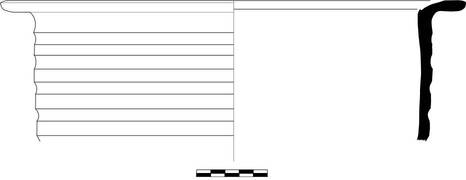
26. Water Jar Toe, Regional? (Mid Roman)
P. H. .117. Est. diam. base .067 (completely preserved). Th. .0095.
K17.0881:7. Compact fabric, brown (5YR 6/8). Frequent tiny mica and few tiny dark inclusions. Buff surface with drippping paint visible under accretion.
K17.0881-7.jpg
27. Middle Roman Amphora 7 Base
P. H. .165. Th. .008.
K/L16/17.0072:2. Single sherd preserves complete hollow base with lower wall. Slightly granular, brown (7.5YR 6/6) fabric with frequent angular light inclusions, fewer dark, and other mostly light bits. There is some uneven firing, lower wall gray towards interior. Surface coated and redder (5YR 6/4).
, pp. 189-193; 77; class 47.
svg/K-L16-17.0072-2.jpg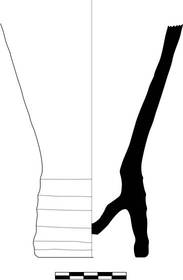
28. Middle Roman Amphora 7 Handle
K/L16/17.0072:4. Single sherd, arched handle to turn.
, pp. 189-193; 77; class 47.
svg/K-L16-17.0072-4.jpg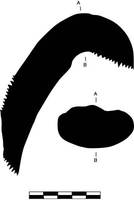
29. Pontic Amphora S IVb/c Rim and Handle (2nd to 4th century AD)
P. H. .125. Est. diam. rim .08 (completely preserved preserved). Th. .0094.
K17.0881:8. Neck with beginning of one handle. Pale (2.5Y 8/3) fabric with very frequent small black inclusions, interspersed with far fewer red chunks. Surface thinly coated to very similar color.
See , pp. 413-415 and fig 7 for discussion of form. Also, , p. 255, type C.
svg/K17.0881-8.jpg